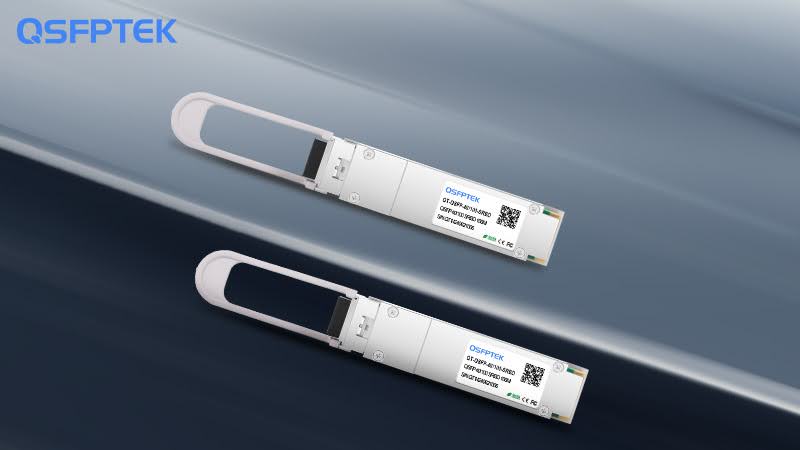With data center traffic growing exponentially, driven by virtualization and the demand for ever-lower latencies, the need to upgrade network infrastructure without replacing existing fiber is a top priority. The QSFP-40/100-SRBD module is positioned as the ideal solution to this challenge, offering a seamless and cost-effective transition to 40G and 100G speeds.
What is the QSFP-40/100-SRBD?
The QSFP-40/100-SRBD is a dual-rate “BiDi” (Bidirectional) QSFP28 optical transceiver designed for short-haul applications over multimode fiber (MMF) cables. Its distinguishing feature is native support for two different speeds: 40 Gigabit Ethernet and 100 Gigabit Ethernet. This makes it an extremely flexible tool for planning network upgrades.
Its compatibility with OM3 and OM4 LC duplex fiber infrastructure is a crucial advantage. In 40G mode, it guarantees transmission distances of up to 100 meters on OM3 and 150 meters on OM4. When operating at 100G, the distances are 70 meters on OM3 and 100 meters on OM4, respectively.
How Does the QSFP-40/100-SRBD Work?
The technology behind this module is fascinating. It integrates electrical data from the host into two optical channels, using a bidirectional VCSEL interface at two different wavelengths (850nm and 900nm). In practice, on a single duplex fiber cable, the module transmits data on one wavelength (e.g., 850nm) and receives it on another (e.g., 900nm). This “BiDi” design enables full-duplex communication using only two fibers, the same ones used by previous 10GbE SR and 40GbE BiDi technologies. On the receiver side, the module reconverts the optical signals into the original four electrical channels.
Key Features and Benefits
Dual-Rate 40G/100G: Maximum flexibility to adapt to different bandwidth and budget requirements.
Compatibility with Existing Infrastructures: Uses the same duplex LC connector type and multimode fiber (OM3/OM4) as 10GbE SR, eliminating cabling replacement costs.
Backward Compatibility: It is backward compatible with 40GbE QSFP+ BiDi standards, protecting previous investments.
Advanced Technologies: Uses PAM4 modulation and Forward Error Correction (FEC) to ensure high-speed data integrity over multimode fiber.
Simplified Upgrade Path: Provides a direct and cost-effective migration path from 10GbE or 40GbE to 100GbE, or simply consolidates 40GbE networks using existing infrastructure.
Comparison with QSFP-100G-SR1.2 and QSFP-40G-SR-BD
Although the QSFP-40G-SR-BD (40G only) and QSFP-100G-SR1.2 (100G only) share the same LC connector and operate over multimode fiber, the QSFP-40/100-SRBD stands out with its dual personality.
| Parameter | QSFP-40/100-SRBD | QSFP-100G-SR1.2 | QSFP-40G-SR-BD |
| Data Rate | 40/100 Gbps | 100 Gbps | 40 Gbps |
| Distance (100G) | 70m (OM3)100m (OM4) | 70m (OM3)100m (OM4) | Not applicable |
| Distance (40G) | 100m (OM3)150m (OM4) | Not applicable | 100m (OM3)150m (OM4) |
| Advantage | Flexible migration to 40G or 100G | Native solution for 100G | Migration from 10G to 40G |
The QSFP-40/100-SRBD combines the advantages of its predecessors in a single module, offering unparalleled future-proofing.
Practical Applications
The primary application of the QSFP-40/100-SRBD is network infrastructure migration. Imagine having a 10GbE backbone that’s starting to show signs of saturation. With this module, you can decide to make an intermediate upgrade to 40GbE, reusing every single duplex LC cable. Later, when your needs grow further, you can move to 100GbE by simply replacing the optical modules at the ends of the link, without ever touching the physical cabling.
This approach not only dramatically reduces upgrade costs (CAPEX) and downtime, but also simplifies inventory management, having a single module capable of serving two different speed generations.
Conclusions
The QSFP-40/100-SRBD is more than just a 100G BiDi QSFP28 transceiver; it’s a strategic enabler for modern data centers. Its ability to natively support both 40G and 100G over existing multimode fiber infrastructure makes it a cost-effective and technically sound choice for enterprises looking to intelligently and sustainably evolve their networks, ensuring high performance today and the flexibility to meet the challenges of tomorrow.


